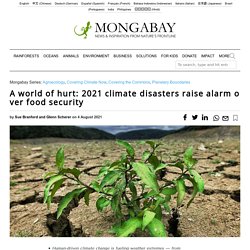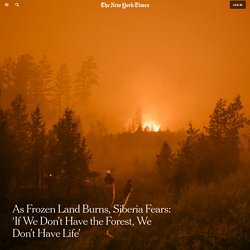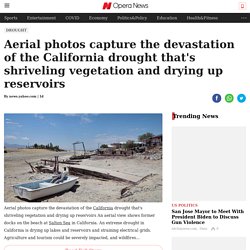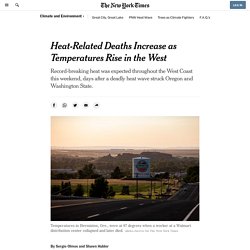

The U.S. just had its hottest summer on record. Oregon wildfires: North Fork residents rebuild after Labor Day fires. A world of hurt: 2021 climate disasters raise alarm over food security. Human-driven climate change is fueling weather extremes — from record drought to massive floods — that are hammering key agricultural regions around the world.From the grain heartland of Argentina to the tomato belt of California to the pork hub of China, extreme weather events have driven down output and driven up global commodity prices.Shortages of water and food have, in turn, prompted political and social strife in 2021, including food protests in Iran and hunger in Madagascar, and threaten to bring escalating misery, civil unrest and war in coming years.Experts warn the problem will only intensify, even in regions currently unaffected by, or thriving from the high prices caused by scarcity.

Global transformational change is urgently needed in agricultural production and consumption patterns, say experts. In July, a video went viral on social media in Argentina showing people walking across what looks like a desert. But it isn’t a desert. What’s happening now is not normal. America in 2090: The Impact of Extreme Heat, in Maps. Yes, it is getting hotter.

And while you might be able to escape the intensifying tropical storms, flooding or droughts by moving elsewhere, refuge from extreme heat is no longer easy to find. Even in Siberia. Summers that seemed exceedingly hot 50 years ago are becoming much more commonplace. The extreme heat of that era — which had a chance of occurring of only one-tenth of 1 percent during the summer season — is now reached more than 20 percent of the time, according to calculations by the climate scientist James Hansen. That’s 200 times as often. America in 2090: The Impact of Extreme Heat, in Maps. As Frozen Land Burns, Siberia Trembles. Northeastern Siberia is a place where people take Arctic temperatures in stride.

But 100-degree days are another matter entirely. Text by Anton Troianovski. Is this the end of forests as we've known them? - SOCAN - Confronting Climate Change. Alastair Gee, The Guardian March 10, 2021 Trees lost to drought and wildfires are not returning.

Climate change is taking a toll on the world’s forests – and radically changing the environment before our eyes Camille Stevens-Rumann never used to worry about seeing dead trees. As a wildland firefighter in the American west, she encountered untold numbers killed in blazes she helped to extinguish. Aerial photos capture the devastation of the California drought that's shriveling vegetation and drying up reservoirs - Opera News. Aerial photos capture the devastation of the California drought that's shriveling vegetation and drying up reservoirs An aerial view shows former docks on the beach at Salton Sea in California.

An extreme drought in California is drying up lakes and reservoirs and straining electrical grids. Agriculture and tourism could be severely impacted, and wildfires... Read Full Story If the content contained herein violates any of your rights, including those of copyright, you are requested to immediately notify us using via the following email address operanews-external(at)opera.com. Heat-Related Deaths Increase as Temperatures Rise in the West. PORTLAND, Ore. — Western states braced for another extreme spike in temperatures this weekend after a recent heat wave in Oregon and Washington State killed nearly 200 people and endangered laborers in fields and warehouses.

Excessive heat warnings were in effect across inland California and the Southwest through the weekend, and the National Weather Service predicted that temperatures would approach an all-time high by Saturday in Las Vegas. A high of at least 130 degrees — which would be one of the highest temperatures reliably recorded on earth — was forecast for Death Valley. In California, the agency that runs the state electrical grid asked residents on Thursday to set their thermostats at 78 degrees or higher to reduce power usage, and Gov. Gavin Newsom expanded a regional drought emergency to cover all but eight of the state’s 58 counties. He also asked Californians to cut their water consumption by 15 percent. In California’s interior, there’s no escape from the desperate heat: ‘Why are we even here?’ In Cantua, a small town deep within California’s farming heartland, the heat had always been a part of life.

“We can do nothing against it,” said Julia Mendoza, who’s lived in this town for 27 years. But lately, she says, the searing temperatures are almost unlivable. By midday on Thursday, the first day of a protracted, extreme heatwave in California’s Central Valley, the country roads were sizzling with heat. A young volunteer with a local environmental justice non-profit who had come to check in on the neighborhood collapsed on the sidewalk, her face bright red and damp. Construction crews working nearby quickly swept her into an air-conditioned car and handed her a cold bottle of water. Why Record-Breaking Overnight Temperatures Are So Concerning. In 2006, a heat wave led to nearly 150 heat-related deaths in California, according to coroners’ reports.

(There were nearly 600 excess deaths during that period, suggesting an even greater effect.) What made that particular heat wave dangerous was its humidity, which traps heat at night, resulting in unusually high nighttime temperatures that caught Californians off guard, said Tarik Benmarhnia, an environmental epidemiologist at the University of California, San Diego.
When cities are affected by extreme heat, poorer communities tend to be most vulnerable, he said.
Extreme temperatures kill 5 million people a year with heat-related deaths rising, study finds. More than 5 million people die each year globally because of excessively hot or cold conditions, a 20-year study has found – and heat-related deaths are on the rise.

The study involving dozens of scientists around the world found that 9.4% of global deaths each year are attributable to heat or cold exposure, equivalent to 74 extra deaths per 100,000 people. It’s prompted calls for better housing insulation and more solar-powered air conditioning, as well as warnings that climate change will increase temperature-linked deaths in the future.
Researchers analysed mortality and weather data from 750 locations in 43 countries between 2000 and 2019, and found the average daily temperature in these locations increased by 0.26C per decade.